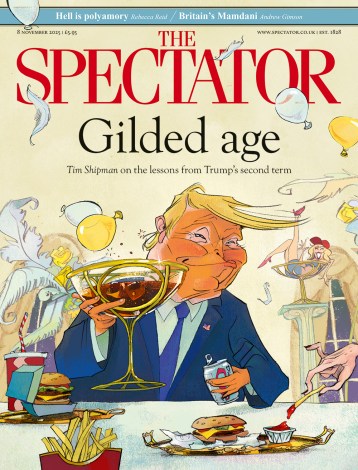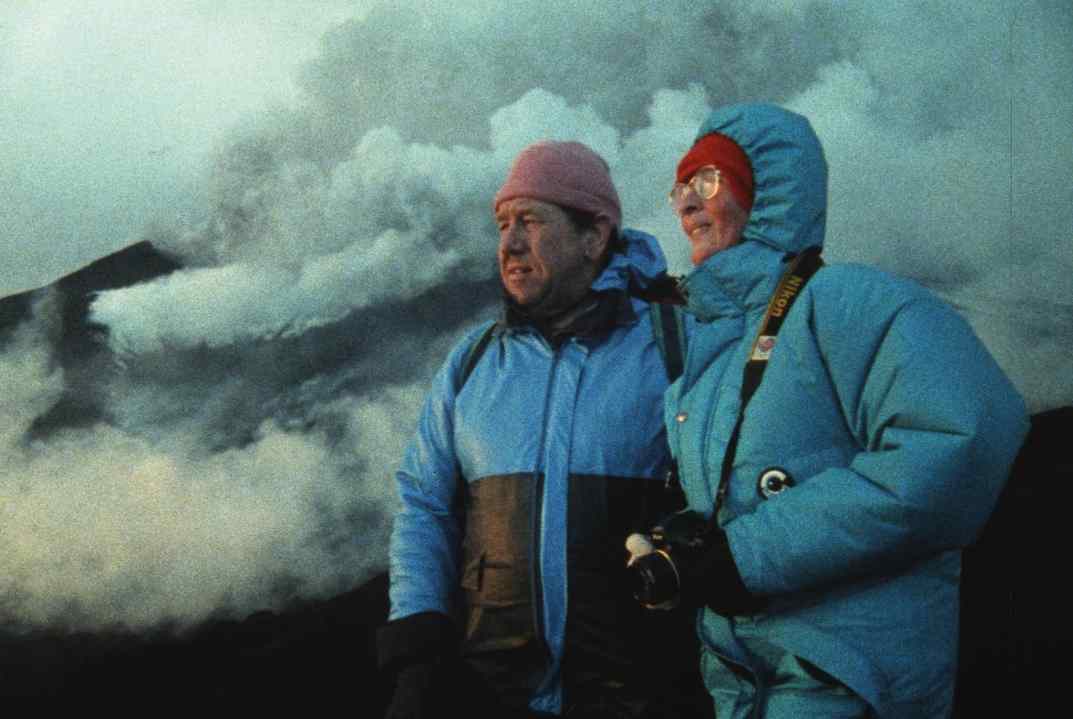Katia and Maurice Krafft were both born in the 1940s in the Rhine valley, close to the Miocene Kaiser volcano, though they didn’t know each other as children. They met on a park bench when they were students at the University of Strasbourg, and from that moment on, according to their joint obituary in the Bulletin of Volcanology, ‘volcanic eruptions became the common passion to which everything else in their life seemed subordinate’. They married in 1970, formed a crack team of volcano-chasers, équipe volcanique, and set off to get as close as they possibly could to the very edge of every fiery crater, to collect samples and data and just to be there, ecstatic with the enormity of it all, like a pair of mad moths drawn into a candle flame.
‘Maurice and Katia were always the first ones there when a volcano erupted,’ says Sara Dosa, the writer and director of Fire of Love, when we meet in Trafalgar Square. ‘They very strategically developed a network of people around the world who would call them as soon as the seismograph started to move. The more we learnt about them as characters, the more I think we fell in love with them, didn’t we?’ Dosa looks at her co-producer and co-writer, Shane Boris. ‘They were just so wise and hilarious and philosophical and idiosyncratic.’
‘Volcanic eruptions became the common passion to which everything else in their life seemed subordinate’
Fire of Love isn’t the first film to feature the extraordinary Kraffts. Some of the silent footage they shot, of dancing walls of fire, and of Katia calmly walking beside boiling rivers of lava has appeared before – most notably in Werner Herzog’s 2016 documentary Into the Inferno. In the Herzog doc the Kraffts are a sideshow, playing second fiddle to the grave, awesome forces of nature and the grave, awesome forces of Herzog himself. What Dosa and her team have done is to make the Kraffts the stars. ‘The real genesis of the project came when we read a sentence in a book that Maurice wrote: “For me, Katia and volcanos, it is a love story,”’ says Dosa, ‘and we thought OK, it’s a love triangle. Let’s make a love triangle movie.’
Dosa and her team spent the 2020 lockdown scouring the archives, sifting through all the 16mm footage the Kraffts shot and about 50 hours of footage of Maurice and Katia from TV shows from the 1970s and ’80s. ‘The 16mm footage didn’t have any sound, so the TV footage meant we could observe their banter and that really allowed us to get into their personalities,’ she says.
Maurice and Katia were exceptional personalities, together and apart – charming and funny but both tough as nuts. At one point in Fire of Love Maurice sets off across a lake of flesh-eating post-volcanic acid in an inflatable dingy. Katia just rolls her eyes, the same way I do when my husband forgets the milk. At another, the skin on Maurice’s shin actually melts and blisters in the volcanic heat, though he’s too busy filming to notice. Both Kraffts find this amusing. In her quieter way, slight, bird-like Katia was just as steely. ‘Should I tell the wall of death story?’ Dosa asks Boris. ‘I realise I’m going on a tangent here,’ Dosa says, ‘but when, I think, Katia was about 15, a fair came to her village and there was one of those rides that was called the Wall of Death and it was a motorcycle that spun horizontally and she hopped on it and was the only one to successfully ride it and became the talk of her town.’
The Kraffts might sound like thrill-seekers, but they weren’t. They were serious scientists and perhaps no one has ever done more to educate the world about the dangers as well as the beauty of volcanoes: ‘Merci, Maurice et Katja, mercy pour tout ce que vous avez donner!’ read a note pinned to their door after they died. But one of the inspiring things about this magical film is that it reminds you that scientific inquiry, joy and an almost mystical sense of wonder can, maybe should, go hand in hand. Boris says: ‘There are certain kinds of scientists throughout history who have felt this way. Feynman, for example. Maurice and Katia were just like that. For them, their contact with volcanos was the highest experience and they had a desire to always be around that and to be around it together. There is something so profound and deep and also so tragic and lonely about that.’
Dosa turns to Boris: ‘Hearing you say that, it reminds me of a sentence that has always kind of haunted me in a book that Katia’s mom wrote. She wrote about how, when Katia went to Iceland in 1968 with Maurice and their other friend, Roland Haas, she came back in love with volcanos and the world, so inspired, so committed to this new pathway for life but there was something about her that seemed melancholy. It haunted me because I felt she was changed. I really feel that they both had this transcendent revelatory experience, and after that there is no going back, you can’t help but go towards that and that’s kind of how they chose to live their life.’
There are two different sorts of volcano: the red ones, overflowing with glowing gore from beneath the Earth’s crust, the volcanoes of nightmares and of six-year-old art, and the more deadly grey ones that erupt in a mushroom cloud of scalding smoke, ash and rock. It was the grey sort that got Katia and Maurice in the end. They were caught in the great blast, a pyroclastic flow that rolled out of Mount Unzen in Japan on 3 June 1991, and once you’ve seen Dosa’s dreamy, joyful film it seems hard to imagine that they could have gone any other way. ‘When I die, I want it to be at the edge of a volcano,’ Maurice is said to have said.
On 7 June, four days after the eruption, an article in the LA Times reported that investigators had found and identified the charred remains of the 37 people who’d died on Mount Unzen that day. The bodies of the two Kraffts were found closest to the crater’s rim, it said.
Fire of Love is in selected cinemas from 29 July.








Comments